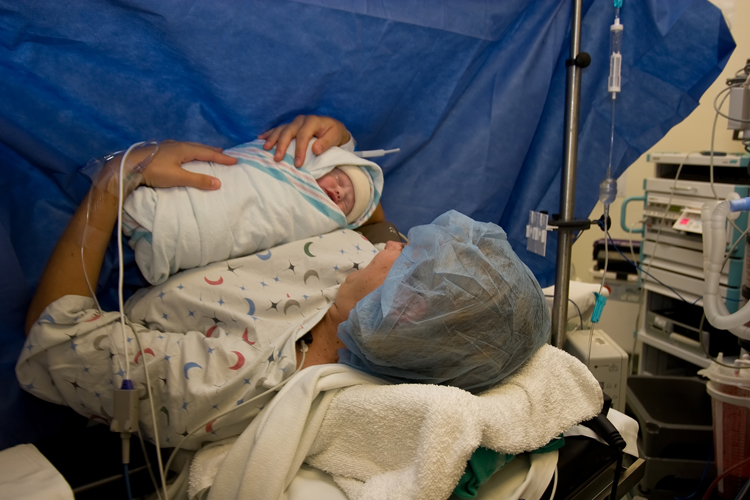Cesarean Awareness Month is organized by the International Cesarean Awareness Network (ICAN) to bring awareness to the number of cesarean births worldwide and prevent unnecessary cesarean births. The month of April also brings additional information and resources about Vaginal Birth After Cesarean (VBAC) since the two are so intricately linked. Doulas are often asked how they support families during and after cesarean births, as well as the impact of our support for families during and after cesarean births. We also sometimes need resources to both answer these questions and expand our knowledge base to better support these families during and after birth.
This time last year, we provided a list of resources for doulas about cesarean births and VBACs. We’ve expanded and updated that list so that you have the resources you need to support families and educate your community on cesarean birth and VBAC, and how doula support impact families during and after cesarean births.
Doulas & Cesareans
The American Congress of Obstetricians and Gynecologists (ACOG) and the Society for Maternal-Fetal Medicine (SMFM) issued a joint statement “Obstetric Care Consensus: Safe Prevention of the Primary Cesarean Delivery” in 2014. In it, doulas are noted as one of the most effective tools available to reduce the cesarean rate.
Late last year, a new study was published demonstrating doula support that included at least one prenatal visit in addition to labor support was correlated with reduced cesarean and preterm birth. Modeling the Cost-Effectiveness of Doula Care Associated with Reductions in Preterm Birth and Cesarean Delivery also demonstrated that doula support helps reduce the cost of maternity care.
ICAN’s website offers “Professional Labor Support,” an article available for download and distribution to clients, students and providers. While focused on the role of doulas in general, the document specifically mentions that mothers planning cesareans and VBACs can benefit from doulas. The writer shares her experience using a doula for her vaginal birth after two cesareans, including a quote from her husband on the support he received from their doula.
“A Doula Can Reduce Your Odds of a Cesarean” is available at vbac.com, and includes links to research showing that women supported by doulas have fewer interventions, including cesareans. The article also provides a good overview of doulas.
The International Cesarean Awareness Network (ICAN) has an article on their blog written by a certified birth doula on the value of doula support for a planned cesarean: http://www.ican-online.org/blog/2015/03/world-doula-week-a-doula-at-a-cesarean-birth/
Postpartum doulas can reference an article on ICAN’s website written by DONA International postpartum doula trainer and Past President Debbie Young sharing how doulas support families after a cesarean birth.
Cesarean Birth Resources
The Truth about C-Sections, a five minute video by renowned birth researcher Eugene Declerq, PhD, is a quick but comprehensive overview dispelling myths about what is driving the c-section rate in the United States.
For a more expanded video on this topic, Birth by the Numbers: Myth and Reality Concerning US Cesareans is a video lecture with visuals by Dr. Declerq lasting just over 20 minutes.
ICAN members can access webinars on birth related topics including 14 Tips to Reduce Your Chance of Cesarean.
What Every Pregnant Woman Needs to Know About Cesarean Section is a 14 page booklet from Childbirth Connection published in 2012.
ICAN offers a reading list on their website useful for both doulas and our clients. Included are books on recovery after a cesarean, collections of stories of women who have had cesareans and chronicles of women who advocated for a VBAC.
A collection of white papers is also available from ICAN on Breastfeeding After A Cesarean, Recovering From A Cesarean – Tips On Healing and The Suture Debate.
The Evidence for Skin-to-Skin Care after a Cesarean is an excellent resource from Evidence Based Birth that outlines the value of skin-to-skin care in general and research specific to skin-to-skin after a c-section.
The Evidence Based Birth site has a collection of articles related to cesarean birth research about some of the reasons care providers recommend cesareans such as a big baby, failure to progress and failed induction. Rebecca Dekker’s site also has articles on skin-to-skin contact in the operating room and keeping mothers and babies together following a cesarean birth. Birth professionals can sign-up for free and download PDF friendly versions of these articles to share with clients.
VBAC Specific Resources
While most c-sections are primary cesareans, about 25% of all c-sections are repeat surgical births. Supporting women who are seeking a VBAC requires unique considerations and preparation for doulas. When planning a VBAC, the mother’s past birth experience is a significant factor in her preparation for her next birth.
ICAN has launched The VBAC Education Project for parents and birth professionals. This evidence-based resource is free and includes slides, handouts, an e-book for educators and a document on hospital policies that support VBAC.
“Making Informed Decisions About VBAC or Repeat Cesareans” from vbac.com is an evidence-based article that outlines what women should know about VBAC and a strong list of resources for additional information helpful to doulas and families, including a Lamaze International webinar.
ACOG offers a brief VBAC Frequently Asked Questions document for maternity care patients which clearly states that mothers who have birthed via cesarean have a choice in how they have their next baby.
In 2010, ACOG released a Practice Bulletin on vaginal birth after cesarean birth which states that patients with one or two previous cesareans, including those carrying twins, are candidates for a trial of labor.
ICAN’s webinar database also includes The VBAC Option, CBAC and the Repeat Cesarean: The Myth of Choice. Available webinars may change so check back for additional topics in the future.
The documentary Trial of Labor was released in 2015 and shares the stories of four women seeking a VBAC. The free preview for birth professionals appears to be have ended, but you can read a our synopsis and inquire with the filmmakers about obtaining the film for your library at trialoflabor.com.
— Adrianne Gordon, CD(DONA), MBA


